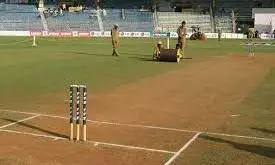Pitches Were Bowler-Friendly But….
India-South Africa Test series turned out to be an action packed contest

To say that the India-South Africa Test series was action packed would be a gross understatement. Two matches, one over in three days, the other over in half that time. This does not happen too often. Indeed there were a couple of major records that have not been notched up in 147 years of Test cricket comprising over 2500 matches.
When something like this happens it is inevitable that the surfaces for the contest will come in for a lot of discussion, mostly critical. The pitches did offer a lot of pace and bounce to the fast bowlers enough to cause the batsmen no little discomfort. But whether there were wickets on which a team could be bowled out for 55, whether six wickets could fall without a run being added to the total and whether a game should be over in five sessions is a moot point.
After all, two batsmen scored hundreds and another got a big hundred. With a certain amount of technique and application, determination and concentration runs could be obtained. Virat Kohli’s two masterly innings of 76 and 46 in the two Tests underscored this.
Against a four-pronged pace attack and on a pitch that had a lot of juice the master batsman confirmed his stature as one of the world’s leading batsmen.
Pitches in South Africa have traditionally favoured pace and bounce and fast bowlers have thrived on it be it the home side or the visitors. Under the circumstances it is not easy to get runs, let alone big scores in South Africa. Even on the last tour two years ago there was only one hundred for both sides in three Tests – KL Rahul – in a series marked by low totals.
South Africa are not the side they were a few years ago. The batting in the absence of stalwarts like Jacques Kallis, AB de Villiers, Faf Du Plessis, Hashim Amla and Graeme Smith is not the same and it was no surprise to see that the Indian pace attack spearheaded by Jasprit Bumrah generally had the measure of them. But the South African speedsters can still pose a problem for visiting sides.
Yes, they don’t have Dale Steyn, Vernon Philander, Mornie Morkel and Makhaya Ntini in their ranks but they have found excellent replacements in Lungi Ngidi, Kagiso Rabada, Marco Jansen and new man Nandre Burger. On the bowler-friendly pitches they proved to be disconcerting for the Indian batsmen.
Ultimately it turned out to be a contest between the pace bowlers of the two sides and both acquitted themselves creditably. The same cannot be said about the batting on both sides. It generally left much to be desired even after taking into account the nature of the surfaces which afforded exaggerated pace and movement Even a cursory glance at the series stats will clearly indicate how the ball dominated the bat.
There is little doubt though that more sporting wickets would have provided an even contest between bat and ball. With the wickets skewed heavily in favour of the bowlers batsmanship was a forgotten art.
One does not advocate a benign wicket on which batsmen can run up huge scores while the bowlers have to struggle for any reward. But it is possible to produce sporting pitches on which batsmen and bowlers have an even chance of succeeding.
It took all of Rohit Sharma’s diplomacy not to be too harsh on the surfaces for the two Tests. Had he done so it wouldn’t be considered as squealing as the series was drawn. He simply termed the conditions as `challenging’ adding that as a batsman he loved to play in such situations.
“It can be dangerous too but we take it up as a challenge,’’ said the Indian captain who, like many others, found the going tough in the series. He however made one valid point. It is also challenging to play when a team comes to India where spin is king so why should there be complaints?
In particular why should pitches in India be described as poor or average just because the ball turns from day one. He was of the view that in the just concluded series the ball shot up from a good length spot, there was exaggerated swing and the bounce was uneven. So why is so much being made about surfaces in India when there is a puff of dust or there are some cracks.
For this reason several pitches in India have been the subject of adverse reports by match referees if they end up in three days or thereabouts. While saying that he would like to see the reports on the pitches at Centurion and Cape Town, Sharma underscored the importance of match referees staying neutral about such things.
“Honestly I am all for pitches like those we just encountered. We love the challenge such pitches pose. We pride ourselves playing on surfaces like this. All I am saying is that the match referees should be neutral in rating pitches everywhere,’’ Sharma said.
Because of what ultimately occurred the pitches will have the final say. Yet one cannot help feeling that those matches could have lasted longer if the batsmen had displayed better technique, more intense concentration and a certain determination as symbolised by the likes of Dean Elgar, Aiden Markram and K. L. Rahul the three century makers.



